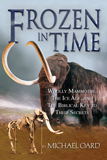Comment on “Land of the Mammoth”
“Land of the Mammoth” on the Discovery Channel was a sequel to the show of last March in which mammoth researchers dug out what they thought was a frozen carcass encased in a block of icy mud.
The presentation of “Land of the Mammoth” on the Discovery Channel, March 11, was a sequel to the show of last March in which mammoth researchers dug out what they thought was a frozen carcass encased in a block of icy mud. The plan was to slowly thaw out the block the next summer and early fall. This was one of two main themes in the “Land of the Mammoth.” However, the researchers were quite disappointed to find only a bit of frozen flesh about the size of a strip of bacon along with 4 vertebrae and 2 ribs. There was no frozen carcass. However, they only thawed out the top 7 inches or so of the block and hope to find the contents of the stomach next year.
The researchers may have been disappointed by their failure to find a frozen carcass, but I wasn’t. I was excited about what they learned about the Taimyr Peninsula of north central Siberia during the mammoth times. The second major theme of the show was the Ice Age fossil discoveries made by a number of teams scouring a small portion of the Taimyr Peninsula for several months. They found many remains of the woolly mammoth and lesser remains of horse, bison, musk ox and other mammals that accompanied the woolly mammoth. They found no carcasses, indicating that carcasses are indeed rare and that the mammals likely did not die of a quick freeze. Carcasses would not be rare if the animals died in a quick freeze as envisioned by some people.
The show also presented the analysis of a tusk core by Daniel Fisher, indicating that the Jarkov mammoth was healthy when it died. It apparently died suddenly, probably in winter, and not in a state of starvation or stress. It is not likely the Jarkov mammoth just dropped over and died as depicted in the show.
An analysis of the pollen in the mammoth hair and the mud surrounding the mammoth indicated the mammoth lived on a grassland. This supports the mammoth steppe hypothesis of Dale Guthrie, which has been controversial. The significance of this grassland is that the climate must have been significantly warmer with light snowfall in winter. Siberia today is dominated by bog vegetation, which is low in nutrition for all but a few mammals, such as the reindeer, moose and musk ox. Bogs are caused by the melting of the top one or two feet of permafrost every summer. The grassland, as well as other factors, implies that the permafrost was either non- existent or at a much deeper level.
Another significant conclusion from the show is that the Jarkov mammoth was encased in what was called “mud,” and this mud is the dominant sediment over the Taimyr Peninsula, as well as most of the lowlands of Siberia. Many researchers have concluded this sediment is actually loess, or wind-blown silt, which is mixed with some clay and sand. When it is wet, it is mud. In Alaska they call it muck. This reinforces the concept that the millions of mammoths entombed in Siberia, Alaska and the Yukon frozen loess were likely killed and buried rapidly by dust storms. They also found green grass plants, indicating the Jarkov mammoth was quickly buried. During the creationist rapid Ice Age, the dry, windy phase at the end would have lasted around 200 years. There must have been huge dust storms to produce the amount of wind-blown silt observed in Siberia. The freezing of the newly-deposited silt explains how the animals ended up in the permafrost. The rare frozen carcasses could be explained by the quick burial in thick loess so that the remains were buried deeply enough and protected by subsequent summer thaws.
The most intense dust storms could have partially or totally covered up a mammoth, explaining why some of the carcasses are buried in a general standing position and suffocated. A woolly mammoth caught in a severe dust storm would act like a snow fence. This would be similar to what happened in the dust bowl era in the 1930s in the midwest of the United States in which some dust storms partially covered up two- story buildings in dust drifts. The uniformitarian scientist cannot see the implication of these dust storms because he stretches out all this loess accumulation over thousands of years. That is why the Jarkov mammoth was depicted in the show as being buried rapidly by a “mud flow.” (Last year, the Discovery Channel depicted the mammoth dying in a lake or pond.) They cannot conceive of such huge dust storms. The problem with the mudflow hypotheses is that most of Siberia is too flat for significant mud flows.
It was also interesting that the researchers had different opinions on the extinction of the woolly mammoths and other animals at the end of the Ice Age. They admit it is still a major mystery. In fact, a third mechanism, disease, was given much air time in the show by Ross MacPhee. MacPhee leans towards this third hypothesis because he sees much evidence against the other two hypotheses, climate change and man the hunter. MacPhee also admitted on the show that he has no evidence. It is quite possible that gigantic dust storms were the cause of the mass extinction, not only in Siberia, but Europe and North America at the end of the Ice Age. There is much evidence for these huge dust storms, in the form of thick loess on the mid- and high- latitude continents, as well as in the Greenland and Antarctic Ice Sheets.
The more the researchers know of the woolly mammoth and his land during the Ice Age, the more it offers support for the rapid Ice Age caused by the Genesis Flood, and for the creation-Flood model based on the Bible.
Recommended Resources

Answers in Genesis is an apologetics ministry, dedicated to helping Christians defend their faith and proclaim the good news of Jesus Christ.
- Customer Service 800.778.3390
- © 2025 Answers in Genesis







